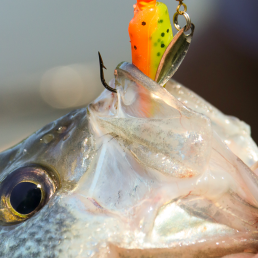Catching Crappies by Degrees
SHARE THIS POST
Crappies are creatures of habit. Knowing their movements and patterns leads to fishing success. Water temperature is one of several determining factors.
80 degrees and hotter
Temperatures are hot in Midsouth waters as summer ends, but are already cooling in northern regions. If patterns of recent years are any indication, cooling will be gradual. Waters like Rend, Kentucky and Reelfoot lakes are still relatively hot.
Crappies are often found in a variety of depths in hot water. If they are hugging a specific structure, like a ledge or under docks, a fisherman can jig, cast or slip-cork. Baits need to be put right on the crappies, but they’ll usually hit a moving target.
When fish are suspended in open water, trolling crankbaits cover lots of water and target fish suspended in the water column. Set your speed to 1.7 mph, vary the depth of baits and stay on the move. Look for channels and big, deep flats. Popular options are Bandit 200 and 300 series, Pico INTs and Berkley Flicker Shads.
70 to 80 degrees
Fishermen should be excited as temperatures start to drop. In late summer and early fall, a downward trend in temperatures signals improved action. When temperatures fall into the mid- to lower 70s, fish become very active. Baitfish are moving into shallower areas and the crappies move in with them. Feeding sprees are common with crappies gorging and gaining weight. Find the schools of shad and minnows and you will likely catch fish. Open-water tactics include pitching and casting using forward-facing sonar, slow trolling using double-minnow rigs and jigs, and fast trolling jigs.
60 to 70 degrees
Action is good throughout this range. Crappies may move around in mid-depth and shallow water, depending upon lake depths and clarity. The key to catching fish is to stay on the move until you find a school of active crappies. Fish may be in 5 feet of water or 15 feet during this transition period. It is a good time to fish, but it’s important to keep an open mind and stay versatile.
One good tip is to downsize baits. In fall, fish like tiny jigs and minnows. Also, look for feeding fish to be near the surface at times, especially if insects are on the water.
50 to 60 degrees
Transition continues and fish are eating. Fish and fishermen enjoy the cool nights and mild days. This temperature range signals a great time to be on the water.
Start your search in mid-depth waters. Crappies will be roaming some but moving toward wintering areas. Try ledges, channels and big flats with cover. It’s time to slow bait presentations. Medium and small baits are good options. Don’t hesitate to try different colors and styles to find the ones fish prefer.
40 to 50 degrees
Crappie fishing becomes stable when waters get cold. Late fall and early winter can be the best fishing of the year because fish are more predictable and in tighter groups.
It’s time to put electronics to full use. Forward-facing sonar is great if you have it. If not, use regular sonar and side imaging to find fish, depths and specific covers where crappies are holding.
Continue with smaller offerings. Jigs allow more versatile presentations including casting, pitching and jigging. Minnows provide the best advantage for still presentations with a slip-float or when tightlining.
Are you enjoying this post?
You can be among the first to get the latest info on where to go, what to use and how to use it!
Watch for light bites. Cold water often results in soft bites that require a fisherman’s attention, or they will be missed.
32 to 40 degrees
Winter fishing is still good, but on-the-water winds and temperatures can be cold in a boat.
Fishing presentations should be slow and slower. Winter homes are the place to find crappies, with structure and cover being important. The key is to find a pattern. If you find fish in wood cover at 20 feet, you’ll likely find them in similar places in other areas of the lake or river.
Reversing the process
Northern fisherman will have ice and ice-out before seeing soft water again. More southerly waters may not ice-over, depending upon winter temperatures.
The following is a quick look at reversal of temperatures and tips for catching.
Cold water that’s warming brings good fishing. It’s still cold, so keep everything super-slow and give fish time to bite.
When temperatures are in the 40s, crappie will be in deep to mid-depth water. They are likely to start easing toward creeks and large coves. Fish are still sluggish but hungry, so good tactics usually lead to good fishing.
Temperatures in the 50s means stable fishing. Crappies are moving to the mid-depths and thinking about spawning/staging areas.
Water in the 60s signals spawning. It’s simple to search for spawning locations, but experience on a lake will help put you in position to catch pre-spawn, spawn and post-spawn crappies.
After post-spawn, with temperatures in the mid-70s and above, summer tactics come back into play.
For more insight and tips for fishing throughout the year, check out the articles in every issue of MidWest Outdoors, available by subscribing on our website.
MWO
SHARE THIS POST
You may also like...
Nothing found.
Did you enjoy this post?
You can be among the first to get the latest info on where to go, what to use and how to use it!
Tim Huffman
Tim Huffman specializes in crappie fishing, is editor for two crappie magazines, as well as writing for several others. In 2018, he published his sixth book, Limiting Out for Crappie, available at Amazon. His first article appeared in MidWest Outdoors in 1988.
